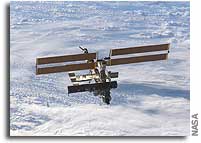ISS On-Orbit Status 23 Feb 2003

All ISS systems continue to function nominally, except as noted previously or below. Sunday rest day for the crew (except for regular routine tasks plus some repair work) and Day 92 in space for Expedition 6. Russian holiday weekend “Defender of the Fatherland Day” continues. Ahead: Week 13.
FE-1 Nikolai Budarin performed the weekly collection of SP toilet flush and SVO water supply counter data for calldown to the ground, well as the periodic check-out of the Elektron oxygen generator’s VM gas/liquid system for air bubbles. Routine replacement of the Elektron’s BKO purification/multifiltration column is scheduled for tomorrow.
Later, Budarin completed the weekly inspection of the BRPK air/liquid separator of the SRVK water processing system in the Service Module (SM).
Budarin today was scheduled to perform off-line testing on the suspect BVK-1 vacuum valve group on the failed Vozdukh carbon dioxide (CO2) scrubber. [To take the BVK off line, the ground first inhibited data output between the BITS2-12 onboard telemetry system and the onboard computer system by turning off VD-SU mode, then powered off the BITS. Next, on MCC-M go-ahead Budarin disconnected the vacuum valve assembly, before BITS and VD-SU were reactivated. Testing of the valve package was then to follow, and if he found the BVK-1 to be failed, Budarin was to replace it with a spare unit, again on MCC-M go-ahead, prior to reconnecting to the BITS in VD-SU mode.]
R3 Computer Transition Status: All three C&C (command & control) MDMs, both GNC (guidance, navigation & control) MDMs and both INT (interior systems) MDMs are fully loaded and configured with their new software. File names for the PCS (portable computer system) laptop displays have been corrected on the primary C&C; work on the other computers is underway. PCS loading will be finished today by installing patch #2 into the remaining units (including the spare).
FE-2/SO Don Pettit prepared the daily IMS inventory file system for auto export/import, and Nikolai performed the routine maintenance of the SOSh life support system.
Don also took the two daily CDMK (CO2 monitoring kit) readings of the ppCO2 levels in SM and Lab, as per Moscow’s request last week.
All crewmembers performed their regular daily physical exercise on TVIS (treadmill with vibration isolation and stabilization), RED (resistive exercise device) and VELO with load trainer.
The crew had their weekly PFCs (private family conferences), via U.S. comm assets.
In support of the ongoing Renal (Kidney) Stone experiment, a special item was placed on the crew’s “job jar” task list for photographing the Renal log book entries and pill pallets’ exterior labels and contents, followed by downlinking the images. This will save vital space for science downmass on Soyuz 5S.
Today’s targets for the CEO (crew earth observations) program were Bangladesh Smog (DYNAMIC EVENT TARGET: An extensive, persistent smog plume is noted by satellite over eastern India and Bangladesh. Crew was to look right of track to document this event), Mekong River Delta (the crew had a nice pass for context views of this large delta and the southern coast of Vietnam), Soufriere Volcano (DYNAMIC EVENT TARGET: Soufriere Hills volcano on the island of Montserrat erupted on Feb. 16, 2003, sending a plume of ash and steam westward over the Caribbean Sea. Crew was to look left of track after crossing Puerto Rico to detect the volcanic plume moving off of this small island), and Newfoundland Ice Floes (with any break at all in the weather the crew will have had optimal illumination of this target area. Looking left of track up the west coast of the big island of Newfoundland toward the Strait of Belle Isle for floes of sea ice lodged against the rugged western coast).
CEO images can be viewed at the website
http://eol.jsc.nasa.gov
ISS Orbit (as of this morning, 7:34am EST [= epoch]):
- Mean altitude — 391.4 km
- Apogee — 399.5 km
- Perigee — 383.3 km
- Period — 92.38 min.
- Inclination (to Equator) — 51.63 deg
- Eccentricity — 0.0011921
- Orbits per 24-hr. day — 15.59
- Mean altitude loss in last 24 hours — 100 m
- Revolutions since FGB/Zarya launch (Nov. ‚98) — 24327
- For more on ISS orbit and worldwide naked-eye visibility dates/times, see
- http://www.hq.nasa.gov/osf/station/viewing/issvis.html








